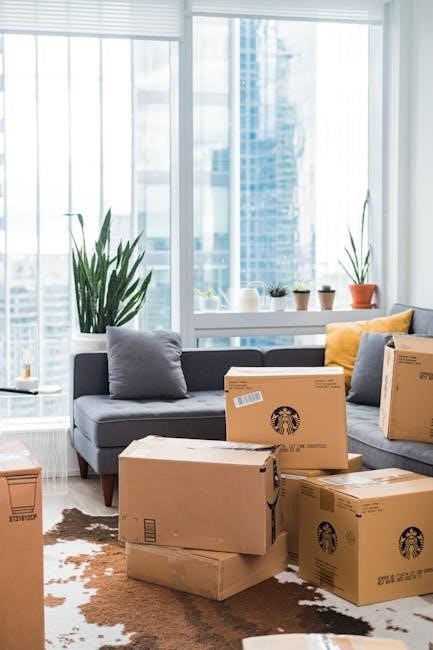A moving house checklist is an essential tool for organizing your relocation. It helps manage tasks, reduce stress, and ensures everything is accounted for. A PDF version is ideal for easy access and planning, making your move seamless and efficient.
1.1 Importance of a Moving Checklist
A moving checklist is crucial for a stress-free relocation. It helps track progress, prevents oversights, and ensures tasks are completed on time. By organizing responsibilities, it saves time and reduces anxiety; A well-structured checklist also improves communication with moving companies and service providers, ensuring a smooth transition. Prioritizing tasks with a checklist minimizes chaos, making the moving process more manageable and efficient from start to finish.
1.2 Benefits of Using a PDF Checklist
A PDF checklist offers versatility and convenience for moving. It can be easily downloaded, printed, and shared with family or movers. The format is accessible on all devices, allowing updates in real-time. PDFs maintain consistency, ensuring clarity and readability. They also provide a permanent record of tasks, reducing the risk of losing track. This makes a PDF checklist an indispensable tool for staying organized during the moving process.

Pre-Move Planning and Preparation
Effective pre-move planning ensures a smooth transition. Create a timeline, set a budget, and organize tasks to avoid last-minute chaos. Stay focused and prepared.
2.1 Creating a Moving Timeline
A moving timeline is crucial for staying on track. Start by breaking down tasks into weekly segments, beginning 8-12 weeks before the move. Week 1-2: Sort and declutter belongings. Week 3-4: Research and book movers or rent a truck. Week 5-6: Start packing non-essential items. Week 7: Finalize packing, transfer utilities, and confirm details. Week 8: Execute the move smoothly.
2.2 Setting a Moving Budget
Setting a moving budget helps manage expenses effectively. Estimate costs for hiring movers, packing materials, and travel. Include deposits for utilities and storage if needed. Track expenses to avoid overspending. Prioritize essential items and allocate funds wisely. Consider hidden costs like furniture disassembly or specialty packing. A well-planned budget ensures financial stability during your relocation.

Decluttering and Organizing Belongings
Decluttering and organizing belongings is crucial for a smooth move. Sort items into keep, donate, or discard categories. This reduces moving costs and stress, ensuring an organized transition.
3.1 Room-by-Room Inventory Checklist
A room-by-room inventory checklist helps track belongings efficiently. Start with high-traffic areas like the living room and kitchen, noting quantities and conditions. This systematic approach ensures nothing is overlooked during packing and moving, making unpacking easier. Use the checklist to categorize items, identify duplicates, and decide what to keep or discard, streamlining your move and reducing clutter in your new home.
3.2 Deciding What to Keep, Donate, or Discard
Deciding what to keep, donate, or discard is crucial for a clutter-free move. Evaluate each item’s sentimental or practical value. Keep essentials, donate gently used items, and discard broken or unnecessary ones; This process helps reduce moving costs and creates space for new belongings. Use your checklist to categorize items and make intentional decisions, ensuring your new home starts organized and clutter-free.

Packing Strategies and Essentials
Packing efficiently requires sturdy boxes, bubble wrap, and clear labels. Start with non-essentials, pack room by room, and keep heavy items separate. Use a checklist to track progress and ensure nothing is missed. Proper packing prevents damage and saves time during unpacking. Organize items logically for a smooth transition to your new home.
4.1 Packing Room by Room
Packing room by room ensures organization and simplifies unpacking. Start with non-essential items, such as seasonal decor or infrequently used kitchenware. Use sturdy boxes and bubble wrap for fragile items. Label each box with its contents and the room it belongs in. Create a master list to track progress. Pack heavier items first and distribute weight evenly. Consider color-coding labels for different rooms to make placement easier. This method helps maintain order and reduces moving stress.
4.2 Essential Items to Pack Separately
Always pack essential items like medications, toiletries, and a change of clothes separately. Include important documents, such as identification and insurance papers, in an easily accessible folder. Charge your electronics and keep chargers handy. A small toolkit with screws and Allen keys is also vital. Label these items clearly and store them in a dedicated bag or box. This ensures you can access what you need immediately without unpacking everything on moving day.
Legal and Financial Tasks
Update your address with banks, credit cards, and utilities. Notify government agencies and insurance providers. Complete mail redirection forms and transfer home services to your new location.
5.1 Updating Your Address
Updating your address is a critical step in the moving process. Notify banks, credit cards, loans, and government agencies like the post office and voter registration. Inform insurance providers, utility companies, and subscription services. Don’t forget to update your address on streaming platforms and shopping accounts. Use a checklist to ensure no important institutions are missed. This helps avoid missed bills, lost mail, and service disruptions.
5.2 Notifying Banks, Credit Cards, and Utilities
Notify banks, credit card companies, and utility providers of your address change. Update billing information to avoid service disruptions. Schedule final readings for utilities like electricity, water, and gas. Arrange for disconnections at your old home and connections at your new address. Ensure all accounts are transferred smoothly to maintain uninterrupted services and avoid late fees or penalties.
Utility Setup and Disconnections
Schedule utility disconnections at your old home and setup services at your new address. Ensure seamless transitions for electricity, water, and gas to avoid service gaps.
6.1 Setting Up Utilities at the New Home
Setting up utilities at your new home ensures a smooth transition. Contact providers for electricity, water, internet, and gas. Schedule activation dates to match your move-in day. Provide necessary details like address and account information. Confirm meter readings and payment methods. Some providers may require deposits or setup fees. Keep track of confirmation emails and reference numbers for future use. Plan ahead to avoid delays or interruptions in services.
6.2 Scheduling Disconnections at the Old Home
Scheduling disconnections at your old home is crucial to avoid unnecessary charges. Notify utility providers of your move date to ensure services are terminated after you’ve vacated. Provide meter readings to ensure accurate final bills. Arrange for equipment like modems or meters to be returned if required. Keep records of disconnection confirmations and final bill payments for your records. This step ensures a clean transition and avoids any post-move hassles.

Moving Day Essentials
Ensure all items are packed, labeled, and ready for transport. Keep essentials like keys, documents, and a first-night box easily accessible. Verify everything is loaded securely.
7.1 Confirming Moving Details
Confirming moving details ensures a smooth transition. Recheck the moving truck arrival time, parking arrangements, and access points with your removalist. Verify the inventory list and ensure all items are accounted for. Double-check the route and any special instructions for fragile or bulky items. Lastly, confirm contact details for your removalist, real estate agent, and utilities. Having everything verified reduces last-minute hassles and ensures a stress-free moving day.
7.2 Preparing for the Moving Truck Arrival
Ensure the moving truck has clear access by reserving parking and clearing pathways. Charge your devices and have documents ready. Pack essentials like snacks, water, and a first-aid kit. Prepare a “last check” list for final sweeps of each room. Designate someone to oversee loading and unloading. Keep tools handy for disassembling furniture. Stay organized and communicate clearly with the moving team to ensure everything runs smoothly.
Post-Move Tasks
After arriving at your new home, unpack essentials, organize belongings, and check for damages. Update your address with authorities and ensure utilities are fully set up.
8.1 Unpacking and Organizing
Begin by unpacking essential items like toiletries, bedding, and kitchenware. Organize belongings room by room, ensuring everything has a designated place. Label boxes clearly to streamline the process. Unpack non-essential items gradually, focusing on priority areas first. Store seasonal items securely. Update your address with authorities, banks, and services. Ensure utilities are fully operational at your new home.
8.2 Checking for Damages
Inspect furniture, electronics, and boxes for damage. Note any issues on the inventory list. Check walls, floors, and appliances for scratches or dents. Document damages with photos for insurance claims. Contact movers immediately if items are damaged. Ensure all utilities are functional and report any discrepancies to service providers. Address any issues promptly to avoid further complications.
Printable Moving Checklist
A printable moving checklist is a handy PDF guide to track tasks from packing to unpacking. Customize it to fit your needs for a stress-free move.
9.1 How to Download and Use the PDF
To download the moving checklist PDF, click the provided link and save it to your device. Open it in a PDF reader, print it, or edit digitally. Customize the checklist to suit your moving needs by adding or removing tasks. Use it to track progress, ensuring no step is missed. This tool helps stay organized and focused throughout your relocation journey.
9.2 Customizing the Checklist
Customizing the checklist allows you to tailor it to your specific moving needs. You can add or remove sections, prioritize tasks, and include personal deadlines. This ensures that every aspect of your move is accounted for, making the process smoother and less stressful. Use the checklist to stay organized and focused on what matters most. By personalizing the checklist, you ensure a seamless relocation experience.
A moving house checklist is a vital resource for a smooth and stress-free relocation. By organizing tasks, setting timelines, and customizing the checklist, you can ensure every detail is covered. Remember to update your address, notify utilities, and prepare essentials. With proper planning and execution, your move will be efficient and enjoyable. Download a printable PDF checklist today and take control of your moving process with confidence and ease.

